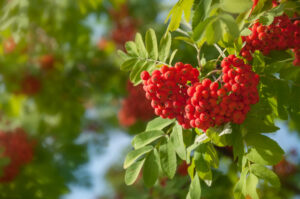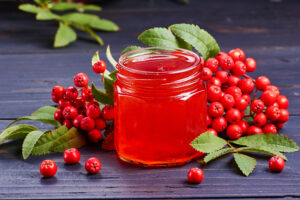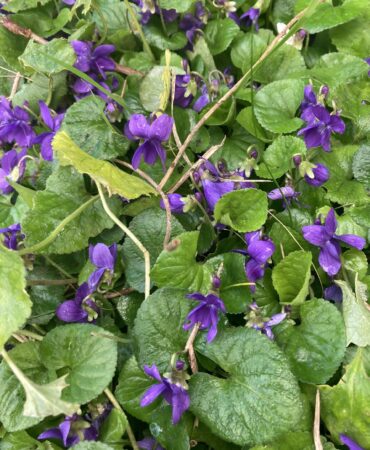Currently Empty: £0.00

Radiant Rowan
Words by Kayleigh Sinclair
—
Radiant Rowan!
Although the Rowan (Sorbus aucuparia) has the common name of mountain ash, it is not related to the Ash tree but takes its name from the similarity between the pinnate leaves arranged alternatively with a terminal leaf at the end.
A relatively hardy plant and native to the British Isles, it can predominately be found in the northern hemisphere but has been found to survive at a sea level of approximately 2000m and can live up to 200 years; in fact, a Rowan is growing in Midlothian, Scotland that is believed to be a portal to another world.
Seasonal ally
Much like the Elder, Rowan indicates the changing seasons, with dense corymbs of flowers in spring turning into heavy clusters of bright orange-red fruits straining down the tree’s boughs in autumn from August to November.

The fruit of the tree contains sorbitol, sorbic and malic acids, and tannins, while the fruit’s seed contains cyanogenic-producing glycosides, which, when exposed to water, produce prussic acid or Hydrogen cyanide.
Sorbic acid
Sorbic acid is a natural preservative whose name originates from the Sorbus aucuparia, as the compound was first isolated from the unripe berries in 1859. Sorbic acid has been found to have excellent antimicrobial properties and as such is used to inhibit yeasts and mould in processed cheeses and meats and is effective in stopping the growth of Salmonella.
Malic acid
Malic acid is a dicarboxylic acid that is created by all living organisms and what gives some fruits their sour taste; it is derived from the Latin’ mālum,’ meaning “apple tree,” which falls under the same family as the Rowan, Rosaceae.
Beneficial rowan
In folk medicine across Europe, both the fruit and the flowers have been used as an anti-inflammatory and antidiarrheal agent and an excellent source of vitamin C to prevent scurvy. In traditional Austrian medicine, they would use specifically the fruits and prepare them as an alcoholic tincture or a tea to treat fevers, infections, and cold.

Mythical rowan
parts of the tree are sacred, burning the wood as incense would increase your psychic ability, and carrying a Rowan staff as a traveller would offer you protections from malevolent mischief and magic you may encounter upon your way.
Much like the Hawthorn and Elder, Rowan plays its part on Beltaine, the beginning of summer when young women rise at dawn to bathe their faces in dew from the Hawthorn while wearing Rowan sprigs (in Edinburgh this is often done on Calton Hill). Like the Elder and the Hawthorn, superstition, and folklore have labelled the Rowan as a Faery tree or the tree of the Goddess.
In Norse mythology, the boughs of the Rowan bent over a river and provided Thor, the God of Thunder, an anchor to hold on to for salvation from the underworld. Because of this legend, it is said that lightning will never strike a Rowan tree.




